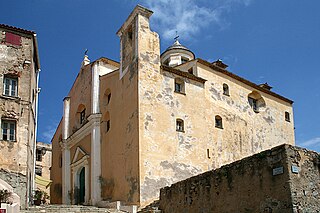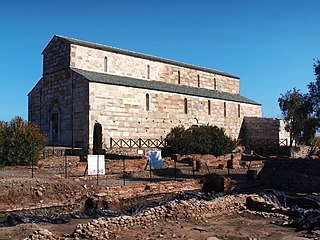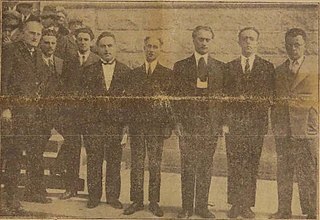 W
WThe history of Corsica goes back to antiquity, and was known to Herodotus, who described Phoenician habitation in the 6th century BCE. Etruscans and Carthaginians expelled the Phoenicians, and remained until the Romans arrived during the Punic Wars in 237 BCE. Vandals occupied it in 430 CE, followed by the Byzantine Empire a century later.
 W
WThe 2015 Corsican protests were a series of marches by several hundred Corsican nationalists that began on 25 December, in Ajaccio, capital of Corsica. During the initial demonstrations, a Muslim prayer hall was burned down and Qur'ans were set alight. Further protests were organised after the initial march despite a government ban on protests until 4 January 2016. The protesters claimed to be acting in revenge for an incident that occurred the day prior when firefighters and police were assaulted in the neighbourhood of Jardins de l'Empereur; however, outside observers labeled the ensuing riots as anti-Arab and anti-Muslim. The Corsican nationalist politicians have claimed their view does not legitimise xenophobia, blaming the protest on French nationalism instead. Scholarly opinions on this claim are divided.
 W
WThe Diocese of Accia was a Roman Catholic bishopric on the island of Corsica. It is now a titular diocese. The diocese was located in the town of Accia in the interior region of Haute-Corse, which was destroyed and from which only some ruins remain. Established in 824 AD it was merged with the Diocese of Mariana in 1554. In 1570 the Bishop of Mariana and Accia moved his seat to Bastia.
 W
WAn Account of Corsica is the earliest piece of writing related to the Grand Tour literature that was written by the Scottish author James Boswell. Its first and second editions were published in 1768, with a third edition within twelve months. The full title given to the journal is An account of Corsica, the journal of a tour to that island and memoirs of Pascal Paoli.
 W
WThe history of Corsica in ancient times was characterised by contests for control of the island among various foreign powers. The successors of the neolithic cultures of the island were able to maintain their distinctive traditions even into Roman times, despite the successive interventions of Etruscans, Carthaginians or Phoenicians, and Greeks. A long period of Roman rule was followed by renewed conflict for control of the island by the Vandals, Byzantines and Saracens.
 W
WThe Anglo-Corsican Kingdom was a client state of the Kingdom of Great Britain that existed on the island of Corsica between 1794 and 1796, during the French Revolutionary Wars.
 W
WArrigo Della Rocca was a nobleman who dominated the political life of Corsica during the second half of the 14th century. Partisan of an aristocratic regime, he was supported by the Crown of Aragon and opposed by the plebeians and the Republic of Genoa.
 W
WThe Action off Bastia was a naval battle fought on 9 September 1943 off Bastia in the Mediterranean Sea. It was one of the few successful Italian reactions to Operation Achse, and one of the first acts of resistance by the Italian armed forces against Nazi Germany after the armistice of Cassibile.
 W
WBastia Cathedral is a former Roman Catholic cathedral in Bastia on the island of Corsica. It has been listed since 2000 as a monument historique by the French Ministry of Culture.
 W
WCalvi Cathedral is a former Roman Catholic church located in Calvi on the island of Corsica, France. It was the episcopal seat of the Bishop of Sagona, which in 1801 was succeeded by the Bishopric of Ajaccio. The cathedral is a national monument.
 W
WConstitutional Project for Corsica is the second of Jean-Jacques Rousseau's three works on political affairs--the first being The Social Contract, and the last being Considerations on the Government of Poland.
 W
WThe Corsican conflict is a nationalist conflict in Corsica during the mid 20th century and the early 21st century. Also known as the French Troubles, and the Conflict in Corsica, it is sometimes described as a low-intensity conflict. The conflict began in 1976.
 W
WThe Corsican Guard was a military unit of the Papal States composed exclusively of Corsican mercenaries on duty in Rome, having the functions of an urban militia and guard for the Pope.
 W
WThe Corsican Guard Affair was an event in French and papal history, illustrating Louis XIV of France's will to impose his power on other European leaders.
 W
WCorsican immigration to Puerto Rico resulted in the 19th century from widespread economic and political changes in Europe that made life difficult for the peasant and agricultural classes in Corsica and other territories. The Second Industrial Revolution drew more people into urban areas for work, widespread crop failure resulted from long periods of drought, and crop diseases, and political discontent rose. In the early nineteenth century, Spain lost most of its possessions in the so-called "New World" as its colonies won independence. It feared rebellion in its last two Caribbean colonies: Puerto Rico and Cuba. The Spanish Crown had issued the Royal Decree of Graces of 1815 which fostered and encouraged the immigration of European Catholics, even if not of Spanish origin, to its Caribbean colonies.
 W
WThe French conquest of Corsica was a successful expedition by French forces of the Kingdom of France under Comte de Vaux, against Corsican forces under Pasquale Paoli of the Corsican Republic. The expedition was launched in May 1768, in the aftermath of the Seven Years' War. A French expeditionary force was landed on the island of Corsica, then ruled by the Corsican Republic. Marching inland to overcome any Corsican opposition, the French force initially suffered an unexpected defeat at the Battle of Borgo. But a new commander, the Comte de Vaux, was appointed to lead the expedition, and decisively defeated the Corsican army at the Battle of Ponte Novu in 1769, effectively bringing an end to Corsican resistance.
 W
WPetru Giovacchini was a Corsican activist, born in Canale-di-Verde to an old noble Corsican family with deep-rooted pro-Italian feelings. Giovacchini was the most renowned of the Corsican Italians, who actively promoted the unification of Corsica to the Kingdom of Italy during the Fascist years.
 W
WThe Invasion of Corsica of 1553 occurred when French, Ottoman, and Corsican exile forces combined to capture the island of Corsica from the Genoese.
 W
WItalian irredentism in Corsica was a cultural and historical movement promoted by Italians and by people from Corsica who identified themselves as part of Italy rather than France, and promoted the Italian annexation of the island.
 W
WItalian-occupied Corsica refers to the military occupation by the Kingdom of Italy of the island of Corsica during World War II. It lasted from November 1942 to September 1943.
 W
WThe Kingdom of Corsica was a short-lived kingdom on the island of Corsica. It was formed after the islanders crowned the German adventurer Theodor Stephan Freiherr von Neuhoff as King of Corsica.
 W
WLouis Charles René, comte de Marbeuf, grand-cross of the order of Saint Louis, was a French general.
 W
WMariana is a Roman site south of Biguglia, in the Haute-Corse département of the Corsica région of south-east France. It lies in the littoral area known as La Marana, near the present town of Lucciana. There are two old churches in the area — the Church of Santa Maria Assunta and San Parteo Church.
 W
WThe history of Corsica in the medieval period begins with the collapse of the Western Roman Empire and the invasions of various Germanic peoples in the fifth century AD, and ends with the complete subjection of the island to the authority of the Bank of San Giorgio in 1511.
 W
WThe prehistory of Corsica is analogous to the prehistories of the other islands in the Mediterranean Sea, such as Sicily, Sardinia, Malta and Cyprus, which could only be accessed by boat and featured cultures that were to some degree insular; that is, modified from the traditional Paleolithic, Mesolithic, Neolithic and Chalcolithic of European prehistoric cultures. The islands of the Aegean Sea and Crete early developed Bronze Age civilizations and are accordingly usually treated under those categories. Stone Age Crete however shares some of the features of the prehistoric Mediterranean islands.
 W
WIn November 1755, Pasquale Paoli proclaimed Corsica a sovereign nation, the Corsican Republic, independent from the Republic of Genoa. He created the Corsican Constitution, which was the first constitution written in Italian under Enlightenment principles, including the first implementation of female suffrage, later revoked by the French when they took over the island in 1769. The republic created an administration and justice system, and founded an army.
 W
WPetru Rocca was a Corsican politician and writer who supported Corsican independence from France. Initially he advocated regionalism for Corsica within the French state. He briefly supported Italian irredentism in Corsica in the later 1930s, before returning to a position of French-Corsican regionalism during World War II.
 W
WThe Province of Sardinia and Corsica was an ancient Roman province including the islands of Sardinia and Corsica.
 W
WAlexander Sauli, C.R.S.P. was an Italian priest who is called the "Apostle of Corsica". He is a saint of the Roman Catholic Church. In 1571, he was appointed by Pius V to the ancient see of Aleria, Corsica, where he rebuilt churches, founded colleges and seminaries, and, despite the depredations of corsairs, placed the Church in a flourishing condition.
 W
WTheodore I of Corsica, born Theodor Stephan Freiherr von Neuhoff, was a German adventurer who was briefly King of Corsica. Theodore is the subject of an opera by G. Paisiello, Il re Teodoro in Venezia, and one of the six kings in Venice in Voltaire's Candide.
 W
WThe Treaty of Bastia was an agreement signed in 1814 between Corsican nationalists and Lord William Bentinck, commander of British forces in Italy. It gave sovereignty over the island to the British Crown, while allowing local self-government.
 W
WThe Treaty of Versailles was concluded on 15 May 1768 at Versailles between the Republic of Genoa and France. Genoa put Corsica in pledge to France.
 W
WThe Vandal Kingdom or Kingdom of the Vandals and Alans was established by the Germanic Vandal people under Gaiseric. It ruled in North Africa and the Mediterranean 435–534 CE.
 W
WNoël Jourda de Vaux, comte de Vaux, seigneur d'Artiac was a French nobleman and General. He oversaw the conquest of the Corsican Republic in 1769. He was given command of land forces in the planned Franco-Spanish Invasion of Britain in 1779, but this was abandoned. He became a Marshal of France in 1783. He was the son of Jean Baptiste Jourda de Vaux, seigneur de Retournac and Marie Anne de Saint-Germain.